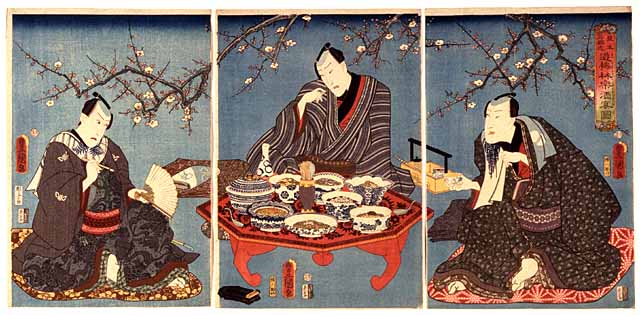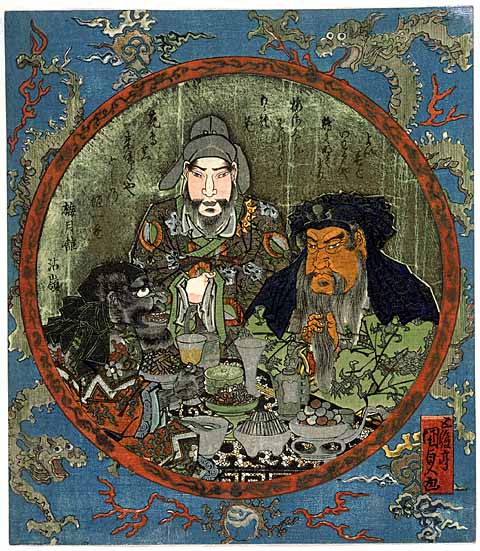
Mitate Sangoku-shi bairin ni asondeshuen o tanoshimu zu (Comparison with ‘Romance of the Three Kingdoms’: Picture of enjoying a banquet in the plum orchard)
Kunisada 53
01/1859
Given by the Friends of the Fitzwilliam with the aid of the MGC Purchase Grant Fund and the National Art Collections Fund.
A triptych published by Ebisuya Shoshichi of the Kabuki actors Nakamura Fukusuke I (right), Ichikawa Ichizo III (centre) and Kawarazaki Gonjuro I (left), enjoying a picnic in a plum orchard. The print alludes to the famous scene in which the three heroes of the Chinese kingdom of Shu (Guan Yu, Liu Bei and Zhang Fei) exchanged oaths of brotherhood while drinking wine in a peach orchard. Their tale was best known through the Chinese novel Romance of the three kingdoms, which was introduced into Japan in the early Edo period and remains popular today. The orchard scene often appeared in paintings and prints, such as the surimono by Kunisada.
Collections Record: P.76-1999

Three heroes of the kingdom of Shu
c.1825
Given to the Fitzwilliam Museum by E. Evelyn Barron in 1937
This surimono depicts Guan Yu, Liu Bei and Zhang Fei, who were known as Shoku sanketsu - the three heroes of the Chinese kingdom of Shu (modern Szechuan Province) in the 4th century a.d. Their tale was best known through the Chinese novel Romance of the three kingdoms, which was introduced into Japan in the early Edo period and remains popular today. They were usually depicted in the famous scene when they exchanged oaths of brotherhood while drinking wine in a peach orchard. Their appearance on New Year surimono was usually combined with poems linking their attributes to conventional phrases and epithets for spring. One of the poems on this print likens the seasonal plum, cherry and peach to the ‘three brothers’. The second poem makes reference to the incident in the legend of Ama no iwato when the cock crowed to lure the sun goddess Amaterasu out of the cave where she was hiding and thereby casting darkness over the world. The print was probably designed for spring in the year of the cock 1825.
The cherry orchard scene was so well-known that it was often parodied in prints.
Collections Record: P.504-1937



